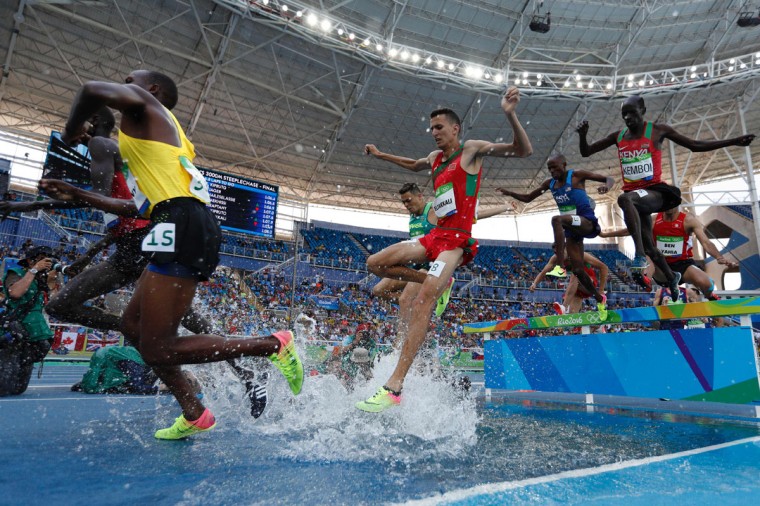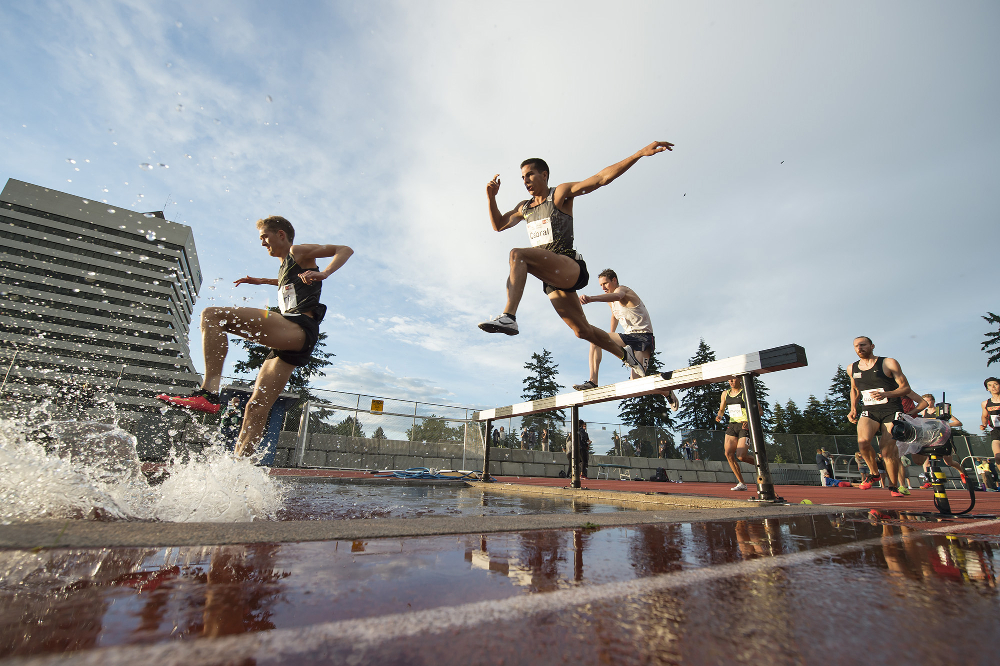Steeplechase History and Evolution: Steeplechase Olympics Fall

The steeplechase, a thrilling and demanding race that incorporates obstacles, has a rich history that spans centuries. Its evolution, from its humble beginnings as a hunting pursuit to its current status as an Olympic event, reflects the changing landscape of sports and the enduring appeal of athletic competition.
Origins and Early Development
The origins of the steeplechase can be traced back to 18th-century England, where fox hunting was a popular pastime among the aristocracy. The sport’s name derives from the “steeple,” a prominent landmark that often served as a visual target for riders. As the hunt progressed, riders would navigate challenging terrain, including fences, ditches, and other obstacles, making their way towards the steeple. Over time, this pursuit evolved into a formalized race, with standardized obstacles and courses.
Steeplechase in the Olympics
The steeplechase was first included in the Olympic Games in 1900, held in Paris. The initial event was contested over a distance of 2,500 meters, with obstacles consisting of a series of hurdles and a water jump. The modern steeplechase, with its 3,000-meter distance and distinctive water jump, was established in the 1920s. The steeplechase has since become a staple of the Olympic athletics program, attracting some of the world’s most talented and determined athletes.
Rules and Regulations, Steeplechase olympics fall
The rules and regulations governing steeplechase racing have evolved over time, with variations across different eras and regions. Some key differences include:
Obstacle Design and Placement
- Early steeplechase races often featured a variety of obstacles, including natural features like fences, ditches, and walls.
- Modern steeplechase races typically include standardized obstacles, such as hurdles and a water jump, with specific dimensions and placements.
Water Jump Variations
- The water jump, a defining feature of the steeplechase, has undergone variations in design and placement.
- In early races, the water jump was often a natural body of water, while in modern races, it is typically a man-made pool with a specific length and depth.
Distance and Course Layout
- The distance of the steeplechase has varied throughout its history, with races ranging from 2,500 meters to 3,000 meters.
- The course layout has also evolved, with modern races featuring a standardized number of obstacles and a specific configuration.
Steeplechase Technique and Strategy

The steeplechase, a unique and challenging event in track and field, demands a perfect blend of speed, endurance, and obstacle-specific skills. Steeplechase runners navigate a course littered with hurdles and a water jump, requiring them to maintain their pace while overcoming these obstacles efficiently. This section delves into the intricacies of steeplechase technique and strategy, outlining the key elements that contribute to success in this demanding discipline.
Hurdle Clearance
Hurdle clearance in the steeplechase differs from traditional hurdle races due to the higher height of the steeplechase hurdles (36 inches compared to 30 inches) and the presence of a water jump. To overcome these obstacles effectively, runners employ a specific technique:
- Approach: Runners approach the hurdle with a strong, rhythmic stride, maintaining a consistent pace. The approach angle should be slightly wider than in a standard hurdle race to allow for a more powerful takeoff.
- Takeoff: The takeoff leg is driven powerfully forward, propelling the runner upwards and over the hurdle. The lead leg is lifted high, ensuring clearance over the top of the hurdle.
- Clearance: The runner’s body remains upright and streamlined throughout the hurdle clearance, minimizing air resistance. The arms are swung naturally to maintain balance.
- Landing: The landing leg is placed firmly on the ground, absorbing the impact and ensuring a smooth transition into the next stride. The runner quickly recovers and maintains their momentum.
Water Jump Technique
The water jump, a defining feature of the steeplechase, presents a unique challenge for runners. The jump requires a combination of speed, technique, and courage to avoid a splash landing:
- Approach: Runners approach the water jump with a slightly reduced pace, allowing for a controlled takeoff. The final strides before the jump are crucial for maintaining momentum.
- Takeoff: The takeoff leg is driven powerfully forward, launching the runner over the water. The lead leg is extended high, clearing the water barrier.
- Landing: Runners aim to land on the far side of the water jump with their feet close together, minimizing the impact and preventing a splash landing. The landing should be quick and decisive, allowing for a smooth transition back into the race.
Pacing Strategies
Effective pacing is crucial in the steeplechase, as runners must balance their speed and endurance over a long distance. Common pacing strategies include:
- Even Pacing: Runners maintain a consistent pace throughout the race, avoiding surges or dips in speed. This strategy is effective for conserving energy and maintaining a steady rhythm.
- Negative Split: Runners start at a slower pace and gradually increase their speed in the latter stages of the race. This strategy allows runners to conserve energy early on and finish strong.
- Surge and Recover: Runners may employ a series of surges to break away from the pack or respond to other competitors. This strategy requires a high level of fitness and tactical awareness.
Training Regimen for Steeplechase Runners
A comprehensive training regimen for steeplechase runners focuses on developing speed, endurance, and obstacle-specific skills:
- Speed Training: This includes drills like sprints, hill sprints, and plyometrics, which enhance explosiveness and quickness. These exercises build the muscles required for powerful takeoffs and landings over hurdles and the water jump.
- Endurance Training: Long runs, tempo runs, and interval training are essential for building aerobic capacity and stamina. This training helps runners maintain their pace over the entire distance of the race, while navigating obstacles effectively.
- Obstacle-Specific Training: This involves practicing hurdle clearance and water jump technique, focusing on proper form and efficient movement. Runners may also practice over specific obstacles to develop muscle memory and confidence.
Notable Steeplechase Athletes and Performances

The steeplechase has witnessed numerous extraordinary athletes who have pushed the boundaries of human endurance and left an indelible mark on the sport. From Olympic champions to world record holders, these individuals have captivated audiences with their grit, determination, and breathtaking performances. This section explores the legacies of some of the most notable steeplechase athletes and their remarkable achievements.
Top Steeplechase Athletes
- Saif Saaeed Shaheen (formerly Stephen Cherono), a Qatari athlete of Kenyan origin, holds the current world record in the steeplechase with a time of 7:53.63, set in Brussels, Belgium, in 2004. Shaheen’s dominance in the event was evident throughout his career, as he also won the 2003 World Championships and the 2004 Olympic Games.
- Ezekiel Kemboi, a Kenyan athlete, is widely regarded as one of the greatest steeplechasers of all time. He has won four Olympic medals, including two golds (2012 and 2016), and three World Championships. Kemboi’s signature move, the “Kemboi kick,” has become iconic in the steeplechase, showcasing his remarkable speed and agility.
- Conny Sodergren, a Swedish athlete, was a dominant force in the steeplechase during the 1990s. He won the 1995 World Championships and the 1996 Olympic Games, and his performances helped to raise the profile of the event.
- Julius Kariuki, a Kenyan athlete, won the 1987 World Championships and the 1988 Olympic Games, establishing himself as a pioneer of the modern steeplechase.
- Bernard Lagat, a Kenyan-American athlete, is a multi-time world champion and Olympic medalist in both the 1500 meters and the steeplechase. He won the 2007 World Championships and the 2011 World Championships in the steeplechase, showcasing his versatility and exceptional endurance.
Top Ten Fastest Steeplechase Times in History
The following table showcases the top ten fastest steeplechase times in history, highlighting the remarkable performances achieved by these athletes:
| Rank | Time | Athlete | Nationality | Date | Location |
|---|---|---|---|---|---|
| 1 | 7:53.63 | Saif Saaeed Shaheen | Qatar | September 3, 2004 | Brussels, Belgium |
| 2 | 7:55.28 | Ezekiel Kemboi | Kenya | September 10, 2011 | Brussels, Belgium |
| 3 | 7:55.72 | Brimin Kipruto | Kenya | July 20, 2011 | Monaco |
| 4 | 7:56.85 | Conseslus Kipruto | Kenya | July 22, 2017 | Monaco |
| 5 | 7:57.16 | Saif Saaeed Shaheen | Qatar | July 27, 2003 | Monaco |
| 6 | 7:58.13 | Ezekiel Kemboi | Kenya | July 18, 2004 | Monaco |
| 7 | 7:58.61 | Brimin Kipruto | Kenya | August 27, 2011 | Zurich, Switzerland |
| 8 | 7:59.25 | Conseslus Kipruto | Kenya | July 10, 2015 | Paris, France |
| 9 | 7:59.38 | Ezekiel Kemboi | Kenya | July 25, 2008 | Stockholm, Sweden |
| 10 | 7:59.41 | Saif Saaeed Shaheen | Qatar | July 27, 2003 | Monaco |
Technological Advancements and Steeplechase Performance
Technological advancements have played a significant role in enhancing steeplechase performance over time.
- Track surface improvements: The introduction of synthetic track surfaces, such as polyurethane, has provided athletes with a more consistent and resilient running surface, reducing the risk of injuries and allowing for faster times.
- Video analysis: The use of high-speed cameras and video analysis software has enabled coaches and athletes to study their form and technique in detail, identifying areas for improvement and optimizing their performance.
- Training methods: Advances in sports science and training methods, such as altitude training and periodization, have helped athletes to improve their endurance, speed, and strength, leading to faster times.
Steeplechase olympics fall – The steeplechase, a race built on resilience and precision, is often decided by the smallest of margins. One wrong step, a miscalculation, and the entire race can unravel. The fall of Lamecha Girma, a moment captured for posterity , serves as a stark reminder that even the most talented athletes are not immune to the unforgiving nature of this demanding event.
The steeplechase, in its raw and unpredictable essence, continues to captivate audiences with its inherent drama and unexpected twists of fate.
The steeplechase, with its hurdles and water jumps, is a sport demanding both athleticism and resilience. Yet, the fall of an athlete in this grueling event often goes unnoticed, overshadowed by the triumphs of those who finish. Perhaps this is why the design of the Lane Andre leather reclining chair and ottoman , a piece meant for comfort and relaxation, feels so incongruous with the harsh realities of the steeplechase.
After all, while the chair promises solace, the steeplechase demands grit and determination, a stark contrast to the plush leather and gentle recline.